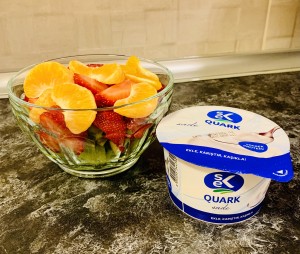My go-to nutritional guide book is Dr. Michael Sharon’s “Nutrients A-Z”*. This user-friendly manual is excellent as every entry is concise and enlightening, and you don’t need a PhD in organic chemistry.
So when I looked up kiwi fruit (or Chinese gooseberry), I was struck by two phrases: “a treasure of nutritional bounty” and “one of the acidic fruits that combines well with protein.” Ideal, I thought, as I love them. And I love combining them with yoghurts, especially when I have no time to cook.
Today’s lunch was two kiwis, six large strawberries and one mandarin orange, sliced up and mixed with a small tub of protein yoghurt. Quick, tasty, filling – and very healthy, as kiwis provide more vitamin C than oranges and more fibre than apples.
One kiwi fruit supplies up to 70mg of vitamin C, or just 5mg less than the average US recommended daily amount for women (it’s 90mg for men). This vitamin cleanses the body and helps boost resistance to disease. An average kiwi also supplies around 250mg of potassium, making it suitable for people with high blood pressure.
Kiwis’ fibre and mucilage content, and its special enzyme called actinidin, can also help with digestion and constipation. Mucilage is a jelly-like substance found in plants and is a rich source of dietary fibre (and is not to be confused with “fuselage”, which contains carbon fibre ;)).
Dietary fibre acts as a laxative, makes you feel full, combats too much cholesterol and sugar in the blood, and can help reduce obesity. Fibre is essential (and, judging by the above list, desirable) and we need to eat 25-30 grammes of it every day. So, as the average kiwi contains around 2.1, my lunch provided around 9.2 grammes, or more than a third of my daily need.
Kiwis should yield slightly to pressure (not be rock hard), are best peeled just before eating, and are nutritionally best when eaten raw. So my lunch idea was a nutritionally sound one. A fat-free yoghurt would also have worked.
So, if all that appeals, then get peeling a kiwi!
*Nutrients A-Z (A User’s Guide to Foods, Herbs, Vitamins, Minerals & Supplements)
Dr. Michael Sharon, Carlton Books, 2009. ISBN 978 1 84732 263 0



Comments are closed.